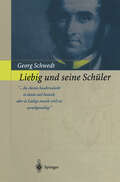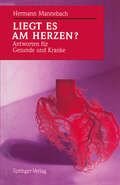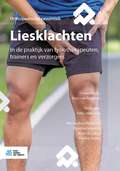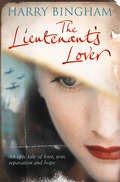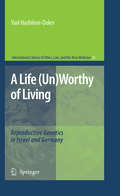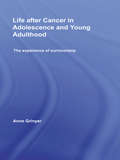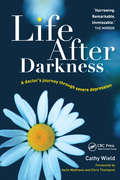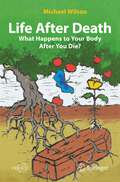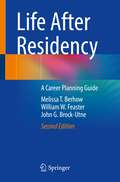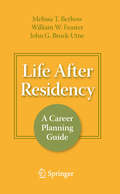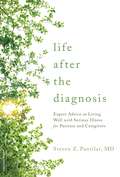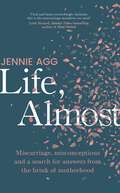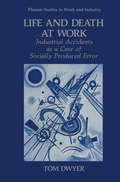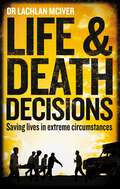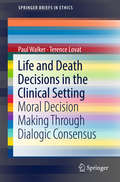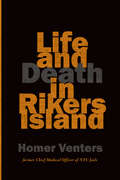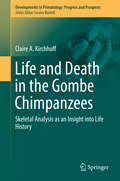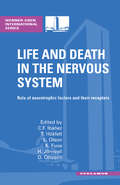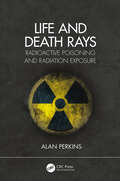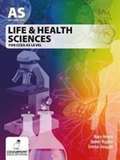- Table View
- List View
Liebig und seine Schüler: Die neue Schule der Chemie
by Georg SchwedtDieses Werk zu Liebigs 200. Geburtstag setzt die Schwerpunkte auf Liebigs eigene Ausbildung und die von ihm entwickelte weitreichende Schule der Chemie.Viele seiner Schüler werden bedeutende Wissenschaftler, Hochschullehrer, wissenschaftliche Schriftsteller und Industriechemiker. Sie kommen nicht nur aus Deutschland sondern aus vielen Ländern Europas, und sogar aus Nord- und Südamerika. Anhand der veröffentlichten Selbstzeugnisse Liebigs, seines umfangreichen Briefwechsels mit WÖHLER, BERZELIUS, dem Verleger VIEWEG und Schülern wie HOFMANN u.a. wird das Wirken Liebigs für eine neue Schule der Chemie dargestellt. Die Biographien der bedeutendsten Schüler werden im Zusammenhang mit Liebigs Einfluss auf die Entwicklung der Chemie in Europa und in den USA behandelt und mit zahlreichen Zitaten aus seinem Briefwechsel ergänzt.
Liesklachten: In de praktijk van fysiotherapeuten, trainers en verzorgers (Orthopedische casuïstiek)
by Koos Van Nugteren Patty JoldersmaDit boek beschrijft veel voorkomende aandoeningen die liespijn kunnen veroorzaken. Besproken worden onder andere de heupdysplasie, coxitis fugax, avulsiefracturen van het bekken, adductorenblessure, het femoroacetabulair impingementsyndroom, coxartrose, stressfractuur, collumfractuur, pubisfractuur, hernia nuclei pulposi en de liesbreuk.Zoals gebruikelijk in de boekenreeks van Orthopedische Casuïstiek wordt ieder onderwerp besproken aan de hand van patiëntencasuïstiek uit de dagelijkse praktijk. De tekst is rijk geïllustreerd met educatieve tekeningen en foto’s. De bijlagen achterin het boek tonen overzichten van kwetsbare locaties in het skelet bij kinderen, tests die men kan gebruiken bij het diagnosticeren van een femoroacetabulair impingementsyndroom, de meest kenmerkende symptomen van een heupartrose en voorbeeldoefeningen die men kan toepassen bij de revalidatie van een totale heupprothese. Het boek is in het bijzonder bestemd voor (sport)fysiotherapeuten, kinesitherapeuten, huisartsen en orthopeden.
The Lieutenant’s Lover
by Harry BinghamSweeping epic of adventure and enduring love, from the revolutionary upheaval in Russia to the chaos of post-War Berlin.
A Life: Reproductive Genetics in Israel and Germany (International Library of Ethics, Law, and the New Medicine #34)
by Yael Hashiloni-DolevThis book presents the findings of a study into the social shaping of reproductive genetics in Germany and Israel. The study reveals dramatic differences between German and Israeli societies in addressing the question of a life (un)worthy of living. A close analysis of the ways that these two societies handle the balance between the quality and sanctity of life illuminates controversies over reproductive genetics in an original and provocative way.
Life After Cancer in Adolescence and Young Adulthood: The Experience of Survivorship
by Anne GrinyerAdolescence and young adulthood is often a difficult enough time without serious illness. However, research has shown that cancer, and surviving cancer, at this age presents distinctive problems medically, socially and psychologically. This important work offers a glimpse into a previously under-researched area and contributes to a better understanding of the needs of young adults post cancer. Focusing not only on the physical effects, but also the social, cognitive, emotional and physiological consequences of surviving cancer in young adulthood, Anne Grinyer draws directly upon data collected from young adults who have been treated for cancer. The book is structured around themes they raised such as fertility; life plans; identity; psychological effects and physical effects. These issues are drawn together in the final chapter and related to clinical and professional practice as well as current policy. This book presents the voices of those who have lived through the experience of cancer in young adulthood, and links them to the theoretical and analytical literature. It will be of interest to professionals and researchers in nursing, social work, counselling and medicine as well as medical sociologists, young adults living with cancer and survivors of young adult cancer.
Life After Cancer in Adolescence and Young Adulthood: The Experience of Survivorship
by Anne GrinyerAdolescence and young adulthood is often a difficult enough time without serious illness. However, research has shown that cancer, and surviving cancer, at this age presents distinctive problems medically, socially and psychologically. This important work offers a glimpse into a previously under-researched area and contributes to a better understanding of the needs of young adults post cancer. Focusing not only on the physical effects, but also the social, cognitive, emotional and physiological consequences of surviving cancer in young adulthood, Anne Grinyer draws directly upon data collected from young adults who have been treated for cancer. The book is structured around themes they raised such as fertility; life plans; identity; psychological effects and physical effects. These issues are drawn together in the final chapter and related to clinical and professional practice as well as current policy. This book presents the voices of those who have lived through the experience of cancer in young adulthood, and links them to the theoretical and analytical literature. It will be of interest to professionals and researchers in nursing, social work, counselling and medicine as well as medical sociologists, young adults living with cancer and survivors of young adult cancer.
Life After Darkness: A Doctor’s Journey Through Severe Depression
by Cathy WieldLife After Darkness is the remarkable and moving story of a doctor and mother of four who endured seven years of severe depression. Self-harm, attempted suicides and admissions to psychiatric units culminated in her resorting to brain surgery as a final attempt to escape her illness. The story of Cathy Wield covers the horrors of time spent in archaic institutions and the loss of any hope, to a full recovery following surgery. Today she has returned to her career and rediscovered the joys of life and her family. This story is one of hope from an often hidden and stigmatized disease.
Life After Darkness: A Doctor’s Journey Through Severe Depression
by Cathy WieldLife After Darkness is the remarkable and moving story of a doctor and mother of four who endured seven years of severe depression. Self-harm, attempted suicides and admissions to psychiatric units culminated in her resorting to brain surgery as a final attempt to escape her illness. The story of Cathy Wield covers the horrors of time spent in archaic institutions and the loss of any hope, to a full recovery following surgery. Today she has returned to her career and rediscovered the joys of life and her family. This story is one of hope from an often hidden and stigmatized disease.
Life After Death: What Happens to Your Body After You Die? (Springer Praxis Books)
by Michael WilsonDeath is not an end – it’s a new beginning. After death, all of the molecules that came together to form the living “you” become nutrients for millions of creatures, large and small. Your body becomes the hub of a complex ecosystem of microbes, insects, worms, plants and more. Cheer up! This book shows how you are going to live forever – as components of so many other wonderful creatures. It describes the science behind the remarkable recycling of your body. We begin with lessons about how your body functions, is a collection of valuable nutrients and is a home to millions of microbes. The book goes on to describe the various stages the body passes through as it decomposes following death. The microbes and insects that make use of your tissues are then introduced. Finally, you will learn about the enduring effects that your body will have on the wider biosphere. We are rich in valuable resources that will end up feeding an immense number and variety of other creatures. Inevitably, your body will support the continuation of life on our beautiful planet – this book describes how all this happens.
Life After Residency: A Career Planning Guide
by Melissa T. Berhow William W. Feaster John G. Brock-UtneThis 2nd edition has been updated and offers residents an even more useful, step-by-step guide to achieving a successful and fulfilling career in medicine. The book's authors began running seminars at Stanford to advise their residents on various important topics not traditionally taught in medical school or residency, but all essential for establishing a successful career in medicine. These topics include creating a curriculum vitae and landing a great job, financial advice for student loans and retirement planning, understanding malpractice insurance, applying to medical staffs, and other important topics. Each chapter from the previous edition is expanded and updated. New chapters have been added to address the following key topics:· EMRs· Payment for services· Leadership· Understanding hospital administration· Physician wellnessLoaded with sage advice and practical wisdom, Life After Residency, 2nd Edition continues to be an invaluable asset for every resident during the transition from residency to life thereafter.
Life After Residency: A Career Planning Guide
by Melissa T. Berhow William W. Feaster John G. Brock-Utne, MD, PhD, FFA(SA)Life After Residency: A Career Planning Guide is an insightful, step-by-step guide to achieving a successful and fulfilling career in medicine. As professors at Stanford University Medical Center, Drs. Melissa Berhow, William Feaster, and John Brock-Utne began running seminars to advise their residents not only on creating a curriculum vitae and landing a great job, but also on how to manage student loan payments and avoid pitfalls in the life of a physician. The immense success and ensuing demand for more seminars eventually gave rise to Life After Residency—a book which continues the seminar discussions in greater depth and magnitude, while maintaining a conversational writing style. Key topics covered include: preparing for a job interview, evaluating job offers and negotiating contracts, obtaining and maintaining the proper State license, applying for membership onto Medical Staffs, obtaining malpractice insurance, buying a house and investing for eventual retirement, and pursuing non-medical career options. Loaded with sage advice and practical wisdom, Life After Residency is an invaluable asset to every resident during the transition from residency to life thereafter.
Life after the Diagnosis: Expert Advice on Living Well with Serious Illness for Patients and Caregivers
by Steven PantilatA renowned expert in palliative care, who is featured in the Netflix documentary, End Game, Dr. Pantilat delivers a compassionate and sensitive guide to living well with serious illness.In Life After the Diagnosis, Dr. Steven Z. Pantilat, a renowned international expert in palliative care demystifies the medical system for patients and their families. He makes sense of what doctors say, what they actually mean, and how to get the best information to help make the best medical decisions. Dr. Pantilat covers everything from the first steps after the diagnosis and finding the right caregiving and support, to planning your future so your loved ones don't have to. He offers advice on how to tackle the most difficult treatment decisions and discussions and shows readers how to choose treatments that help more than they hurt, stay consistent with their values and personal goals, and live as well as possible for as long as possible.
Life after the Diagnosis: Expert Advice on Living Well with Serious Illness for Patients and Caregivers
by Steven PantilatA renowned expert in palliative care, who is featured in the Netflix documentary, End Game, Dr. Pantilat delivers a compassionate and sensitive guide to living well with serious illness. In Life After the Diagnosis, Dr. Steven Z. Pantilat, a renowned international expert in palliative care demystifies the medical system for patients and their families. He makes sense of what doctors say, what they actually mean, and how to get the best information to help make the best medical decisions. Dr. Pantilat covers everything from the first steps after the diagnosis and finding the right caregiving and support, to planning your future so your loved ones don't have to. He offers advice on how to tackle the most difficult treatment decisions and discussions and shows readers how to choose treatments that help more than they hurt, stay consistent with their values and personal goals, and live as well as possible for as long as possible.
Life, Almost: Miscarriage, misconceptions and a search for answers from the brink of motherhood
by Jennie Agg'Vital and heart-wrenchingly intimate' Leah Hazard'Urgent, fascinating and thought-provoking' Julia Bueno'Thoughtfully researched and beautifully written' Pippa VosperAfter losing four pregnancies with no obvious cause, Jennie Agg set out to understand why miscarriage remains such a profoundly misunderstood, under-researched and under-acknowledged experience.Part-memoir, part-scientific investigation, Life, Almost documents Agg's path to motherhood and her search for answers. Tracing each tentative step of her fifth pregnancy - as her body becomes a creature she does not wish to spook - Agg dismantles the myths that we unquestioningly accept about our reproductive lives:· Why are we told miscarriage can't be prevented when half of all miscarriages are of perfectly healthy embryos?· Why is it normal not to tell anyone you're pregnant for the first three months? · Why don't we know why labour starts? Drawing on pioneering research and interviews with world-leading experts, Life, Almost is a ground-breaking book that will change how you think about miscarriage, and a moving reflection on grief and love at the edge of life as we understand it.
Life and Death at Work: Industrial Accidents as a Case of Socially Produced Error (Springer Studies in Work and Industry)
by Tom DwyerLife and Death Decisions: Fighting to save lives from disaster, disease and destruction
by Dr Lachlan McIver***'Just brilliant. The book of the decade.' - Professor Tim Flannery, Former Australian of the Year 'An honest, powerful and riveting book that demonstrates Lachlan's courage in the face of the hardest of circumstances.' - Levison Wood, Award-winning author, explorer and photographer'Wow. A hugely important and enjoyable book that will restore your faith in humanity and what is possible... Deeply moving and at times tragic but never losing a sense of optimism or hope.' - Sir Jeremy Farrar, Director of the Wellcome TrustLachlan was sixteen when he found his father dead on the side of a dirt road in North Queensland, Australia. He had suffered a sudden heart attack and died alone. It was this tragedy that motivated Lachlan to train as a doctor specialising in providing medical care for people living in remote, resource-deprived locations. Lachlan's work with the World Health Organization and Médecins Sans Frontières has taken him to some of the world's most extreme environments, from the sinking islands of the Pacific to epidemics and war zones in the Middle East and sub-Saharan Africa. In this no-holds-barred memoir, Lachlan recounts his experiences treating patients ravaged by tropical diseases, managing war wounds with drug-resistant infections, delivering babies by the light of a head torch, dealing with the devastating effects of climate change and narrowly avoiding being kidnapped by militia in the Democratic Republic of the Congo. Tackling such impossible problems day in and day out inevitably takes a personal toll. Lachlan is ultimately forced to face his own battles with depression, alcohol abuse and bankruptcy.Life and Death Decisions is a deeply human look at the personal cost of our broken global health system and a vital call to action.
Life and Death Decisions in the Clinical Setting: Moral decision making through dialogic consensus (SpringerBriefs in Ethics)
by Paul Walker Terence LovatThis book moves away from the frameworks that have traditionally guided ethical decision-making in the Western clinical setting, towards an inclusive, non-coercive and, reflective dialogic approach to moral decision-making. Inspired in part by Jürgen Habermas’s discourse theory of morality and principles of communicative action, the book offers a proportionist approach as a way of balancing out the wisdom in traditional frameworks, set in the actual reality of the clinical situation at hand. Putting this approach into practice requires having a conversation, a dialogue or a discourse, with collaboration amongst all the stakeholders. The aim of the dialogue is to reach consensus in the decision, via mutual understanding of the values held by the patient and others whom they see as significant. This book aims to underscore the moral philosophical foundations for having a meaningful conversation. Life and Death Decision in the Clinical Setting is especially relevant in our contemporary era, characterised medically by an ever-increasing armamentarium of life-sustaining technology, but also by increasing multiculturalism, a multiplicity of faiths, and increasing value pluralism.
Life and Death in Rikers Island
by Homer VentersKalief Browder was 16 when he was arrested in the Bronx for allegedly stealing a backpack. Unable to raise bail and unwilling to plead guilty to a crime he didn't commit, Browder spent three years in New York's infamous Rikers Island jail;¢;‚¬;€?two in solitary confinement;¢;‚¬;€?while awaiting trial. After his case was dismissed in 2013, Browder returned to his family, haunted by his ordeal. Suffering through the lonely hell of solitary, Browder had been violently attacked by fellow prisoners and corrections officers throughout his incarceration. Consumed with depression, Browder committed suicide in 2015. He was just 22 years old. In Life and Death in Rikers Island, Homer Venters, the former chief medical officer for New York City's jails, explains the profound health risks associated with incarceration. From neglect and sexual abuse to blocked access to care and exposure to brutality, Venters details how jails are designed and run to create new health risks for prisoners;¢;‚¬;€?all while forcing doctors and nurses into complicity or silence. Pairing prisoner experiences with cutting-edge research into prison risk, Venters reveals the disproportionate extent to which the health risks of jail are meted out to those with behavioral health problems and people of color. He also presents compelling data on alternative strategies that can reduce health risks. This revelatory and groundbreaking book concludes with the author's analysis of the case for closing Rikers Island jails and his advice on how to do it for the good of the incarcerated.
Life and Death in Rikers Island
by Homer VentersKalief Browder was 16 when he was arrested in the Bronx for allegedly stealing a backpack. Unable to raise bail and unwilling to plead guilty to a crime he didn't commit, Browder spent three years in New York's infamous Rikers Island jail;¢;‚¬;€?two in solitary confinement;¢;‚¬;€?while awaiting trial. After his case was dismissed in 2013, Browder returned to his family, haunted by his ordeal. Suffering through the lonely hell of solitary, Browder had been violently attacked by fellow prisoners and corrections officers throughout his incarceration. Consumed with depression, Browder committed suicide in 2015. He was just 22 years old. In Life and Death in Rikers Island, Homer Venters, the former chief medical officer for New York City's jails, explains the profound health risks associated with incarceration. From neglect and sexual abuse to blocked access to care and exposure to brutality, Venters details how jails are designed and run to create new health risks for prisoners;¢;‚¬;€?all while forcing doctors and nurses into complicity or silence. Pairing prisoner experiences with cutting-edge research into prison risk, Venters reveals the disproportionate extent to which the health risks of jail are meted out to those with behavioral health problems and people of color. He also presents compelling data on alternative strategies that can reduce health risks. This revelatory and groundbreaking book concludes with the author's analysis of the case for closing Rikers Island jails and his advice on how to do it for the good of the incarcerated.
Life and Death in the Gombe Chimpanzees: Skeletal Analysis as an Insight into Life History (Developments in Primatology: Progress and Prospects)
by Claire A. KirchhoffThis book addresses how skeletons can inform us about behavior by describing skeletal lesions in the Gombe chimpanzees, relating them to known life histories whenever possible, and analyzing demographic patterns in the sample. This is of particular interest to both primatologists and skeletal analysts who have benefited from published data on a smaller, earlier skeletal sample from Gombe. The Gombe skeletal collection is the largest collection of wild chimpanzees with known life histories in existence, and this work significantly expands the skeletal sample from this long-term research site (49 chimpanzees). The book explores topics of general interest to skeletal analysts such as demographic patterns, which injuries leave signs on the skeleton, and rates of healing, and discusses both qualitative and quantitative analysis of the patterning of lesions. The book presents the data in a narrative style similar to that employed in Dr. Goodall’s seminal work The Chimpanzees of Gombe. Readers already familiar with the Gombe chimpanzees are likely to appreciate summaries of life events correlated to observable skeletal features. The book is especially relevant at this time to remind primate conservationists of the importance of the isolated chimpanzee population at Gombe National Park as well as the availability of the skeletons for study, both within the park itself as well as at the University of Minnesota.
Life and Death in the Nervous System: Role of Neurotrophic Factors and Their Receptors
by C.F. IBÁÑEZ, T. HÖKFELT, L. OLSON, K. FUXE, H. JÖRNVALL, D. OTTOSONLife and Death in the Nervous System
Life and Death Rays: Radioactive Poisoning and Radiation Exposure
by Alan PerkinsThis unique book provides an accessible introduction to both the scientific background and the key people involved in the discovery and use of radiation and radioactivity. It begins by providing a short history of radiation exposures and radiation poisoning; from the early inappropriate use of X-rays and radium cures through the misadventures of the Manhattan Project and the Chernobyl disaster, to the high-profile and deliberate poisoning of Alexander Litvinenko in London with polonium-210, which gave rise to worldwide media attention. The chapters provide a catalogue of deliberate criminal acts, unfortunate accidents, and inadvertent radiation exposures, exploring well-known events in detail, as well as some not so well-known occurrences. It works through the topics by focusing on human stories and events and their biological impact. In addition, it covers descriptions of the beneficial uses of radiation and radioactivity. This book can be enjoyed by any reader with a general interest in science, as well as by students and professionals within the scientific and medical communities. Key features Authored by a subject area specialist who has worked in both clinical practice and academia and was involved with the national media following incidents of national and international importance Provides a unique human perspective into well-known and some lesser known events and a concise history of the discovery of radiation and the events that followed Adds scientific and medical background to a subject of high media interest
Life and Death Rays: Radioactive Poisoning and Radiation Exposure
by Alan PerkinsThis unique book provides an accessible introduction to both the scientific background and the key people involved in the discovery and use of radiation and radioactivity. It begins by providing a short history of radiation exposures and radiation poisoning; from the early inappropriate use of X-rays and radium cures through the misadventures of the Manhattan Project and the Chernobyl disaster, to the high-profile and deliberate poisoning of Alexander Litvinenko in London with polonium-210, which gave rise to worldwide media attention. The chapters provide a catalogue of deliberate criminal acts, unfortunate accidents, and inadvertent radiation exposures, exploring well-known events in detail, as well as some not so well-known occurrences. It works through the topics by focusing on human stories and events and their biological impact. In addition, it covers descriptions of the beneficial uses of radiation and radioactivity. This book can be enjoyed by any reader with a general interest in science, as well as by students and professionals within the scientific and medical communities. Key features Authored by a subject area specialist who has worked in both clinical practice and academia and was involved with the national media following incidents of national and international importance Provides a unique human perspective into well-known and some lesser known events and a concise history of the discovery of radiation and the events that followed Adds scientific and medical background to a subject of high media interest
Life And Health Sciences For CCEA AS Level
by Nora Henry James Napier Emma DouganDeveloped specifically to meet the requirements of the new CCEA GCE Life and Health Sciences AS course covering both the Single and Double Award. Contains numerous diagrams, exam tips, worked examples and questions, with answers supplied. Book contents covers the units AS 2, AS 3 and AS 5.
